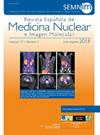Asociación de los hallazgos de la PET-TC y la VATS con la histología pleural en el estudio del derrame pleural
IF 1.6
4区 医学
Q3 RADIOLOGY, NUCLEAR MEDICINE & MEDICAL IMAGING
Revista Espanola De Medicina Nuclear E Imagen Molecular
Pub Date : 2025-01-01
DOI:10.1016/j.remn.2024.500059
引用次数: 0
Abstract
Introduction
Histological analysis of the pleura obtained by video-assisted thoracoscopic surgery (VATS) is the best diagnostic technique in the study of neoplastic pleural effusions. This study evaluates the relationship between positron emission tomography (PET)/computed tomography (CT) and VATS findings, the result of the first pleural biopsy, and the final diagnosis of malignancy or non-malignancy.
Methods
Prospective study of consecutive patients with pleural effusions undergoing PET/CT and VATS from October 2013 to December 2023. The following variables were recorded: PET/CT score (nodular pleural thickening, pleural nodules with standardized uptake value (SUV) > 7.5, lung mass or extra pleural malignancy, mammary lymph node with SUV > 4.5 and cardiomegaly); VATS data (drained volume, visceral and parietal pleural thickening, nodules or masses, septa, plaques, fluid appearance, trapped lung, and suspected diagnosis of the procedure), as well as the histological study of the first pleural biopsy (benign or malignant) and the final diagnosis of benign or malignant pleural effusion. A logistic regression study of the variables was performed.
Results
95.8% of the patients with PET/CT and pleuroscopy not suggestive of malignancy had non-malignant histological findings, while 93.2% of the patients with PET/CT and pleuroscopy suggestive of malignancy had malignant histological findings. PET/CT, pleuroscopy, and the result of the first pleural biopsy showed a significant association with the final diagnosis of pleural effusion.
Conclusions
There is a strong association between PET/CT findings, VATS and pleural histology.
PET-TC和VATS的发现与胸膜组织学在胸膜溢漏研究中的关联
通过电视胸腔镜手术(VATS)对胸膜进行组织学分析是研究肿瘤性胸腔积液的最佳诊断技术。本研究评估正电子发射断层扫描(PET)/计算机断层扫描(CT)与VATS结果、首次胸膜活检结果以及最终诊断恶性或非恶性之间的关系。方法前瞻性研究2013年10月至2023年12月连续接受PET/CT和VATS检查的胸腔积液患者。记录以下变量:PET/CT评分(结节性胸膜增厚,胸膜结节标准化摄取值(SUV) >;7.5、肺肿块或胸膜外恶性肿瘤、乳腺淋巴结合并SUV >;4.5和心脏肥大);VATS数据(排气量、内脏和胸膜壁层增厚、结节或肿块、间隔、斑块、液体外观、肺陷陷和手术的可疑诊断),以及第一次胸膜活检(良性或恶性)的组织学研究和良性或恶性胸膜积液的最终诊断。结果PET/CT及胸腔镜检查未提示恶性的患者组织学表现为非恶性的占95.8%,PET/CT及胸腔镜检查提示恶性的患者组织学表现为恶性的占93.2%。PET/CT、胸膜镜检查和第一次胸膜活检结果显示与最终诊断胸腔积液有显著相关性。结论PET/CT表现、VATS与胸膜组织学有很强的相关性。
本文章由计算机程序翻译,如有差异,请以英文原文为准。
求助全文
约1分钟内获得全文
求助全文
来源期刊

Revista Espanola De Medicina Nuclear E Imagen Molecular
RADIOLOGY, NUCLEAR MEDICINE & MEDICAL IMAGING-
CiteScore
1.10
自引率
16.70%
发文量
85
审稿时长
24 days
期刊介绍:
The Revista Española de Medicina Nuclear e Imagen Molecular (Spanish Journal of Nuclear Medicine and Molecular Imaging), was founded in 1982, and is the official journal of the Spanish Society of Nuclear Medicine and Molecular Imaging, which has more than 700 members.
The Journal, which publishes 6 regular issues per year, has the promotion of research and continuing education in all fields of Nuclear Medicine as its main aim. For this, its principal sections are Originals, Clinical Notes, Images of Interest, and Special Collaboration articles.
 求助内容:
求助内容: 应助结果提醒方式:
应助结果提醒方式:


